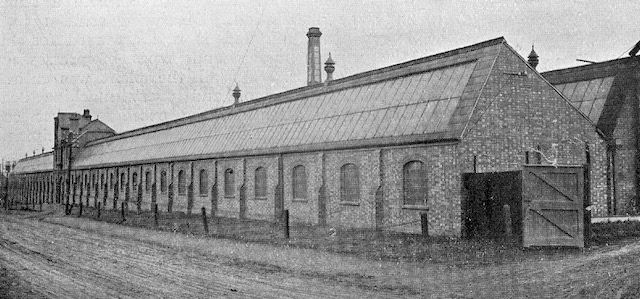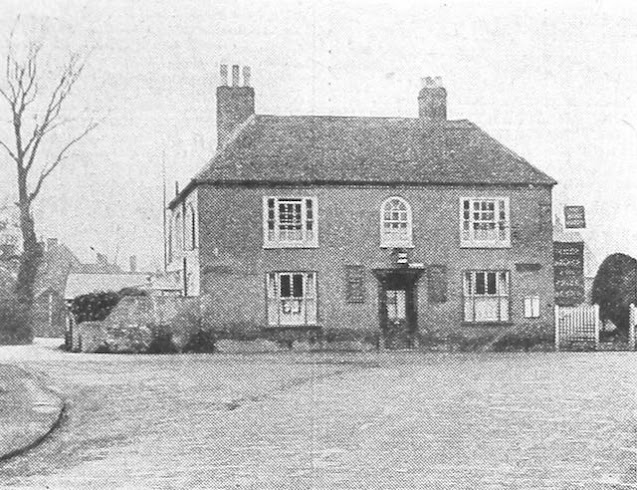In the UK there are approximately 112 roads with the name Tollgate* in them, for all suffixes (lane, way, street, road corner, and so on); in addition there are a modest 15 roads with the word Tollhouse in them.
.jpeg) |
| The first of several Tollgate Road street plates after leaving High Street, Colney Heath. |
The answer to the question why such a route contains Tollhouse or Tollgate must be straightforward enough: during the period of around two centuries up to c1880s (although some closed earlier) in which turnpike roads existed it is surely a section of road approaching a toll gate and/or toll house which will have been given – verbally at least – that most obvious of names.
In much the same way as so many roads in the vicinity of railways are labelled Station Road or Bridge Street.
.jpeg) |
The side road gate and house (no longer extant) near Hatfield Road in Colney Heath Lane. Named
Hut Wood Toll. Painted by John Westall. |
Through our east end of St Albans passes a section of the Reading & Hatfield Turnpike. Today the route is Hatfield Road and St Albans Road East, and if you peruse the website www.stalbansowneastend.org.uk you will discover a whole topic about the R&H, including its side roads which branch from the turnpike and where toll houses and gates lay in wait for those paying a charge.
But there is a road with the label Tollgate Road just east of Colney Heath village, although there appears to be no recorded Turnpike Trust to control this length of road. Tollgate Road begins at the roundabout at the south-east end of High Street, Colney Heath. It retains this name until becoming Dixons Hill Road shortly before reaching and bridging the A1(M), a modern road, although in former times the target would undoubtedly have been the Great North Road which is now labelled A1000.
 |
| High Street view south-east to the start of Tollgate Road. |
.jpeg) |
On the north side of the road was a separate farm known as Little Tollgate Farm, the main farm
on the south side. Both are now Tollgate Farm. |
.jpeg) |
After the road changes its name to Dixons Hill Road in the vicinity of today's A1(M) it passes
through Welham Green. |
Evidence from various maps shows various short sections have been remodelled to enable the road to join the A1(M) and then aim for the A1000 near Welham Green Station where this road is still formally named Great North Road. This section of the Great North road was controlled by the Galley Corner to Lemsford Turnpike Trust (Galley Corner can be found near Enfield).
.jpeg) |
The road crosses over the railway and reaches today's A1000, Great North Road, which was
controlled by the Galley Corner & Lemsford Turnpike Trust. |
So we know of two turnpikes, the Reading & Hatfield, and the Galley Corner & Lemsford, between which appears to be a roughly west-east road by the names of Colney Heath Lane, High Street, Tollgate Road and Dixons Hill Road (formerly just Dixons Hill). The give-away name is, of course, Tollgate Road. Further emphasis is placed on the name as it passes Tollgate Farm, and formerly Little Tollgate Farm on the opposite site of the road. And that's not all; an area of nearby woodland has been called Tollgate Wood.
.jpeg) |
The vehicle is turning into the entrance of (Little) Tollgate Farm, as shown in an earlier photo.
Take note of the green bank beside the road and in front of the car. The constriction would have embanked or possibly fenced to enclose half of the present road's width.
We will observe it on both of the maps below. |
At this point we should refer to a detailed spreadsheet listing all known tollhouses, whether extant or lost, in Hertfordshire**. Number 34 on the list names the gate "North Minns" [sic] but describes the location of the gatehouse as "Tollgate Farm, Colney Heath, Roestock." Further location detail describes "Tollgate Road, from Mimms Hall, north of North Mimms Park." Rather disappointingly, the spreadsheet informs us that, as with the majority of gate houses in the list it is "lost", in other words, it no longer exists and had not done so at the time of the 1890 OS 6 inch map. Visual inspection of the 6 inch and 25 inch map of 1897 confirms this.
Although there were occasional buildings along Tollgate Road at this time, none was labelled Toll House and none existed on the boundary of the road as would be expected if the intention was to restrict road width and stop traffic to collect tolls.
There is one more alleged fact about Tollgate Road. While the majority of turnpikes were organised by Trust – the clues are in their names – an unknown number were privately owned, and the toll road where this house presumably stood was allegedly a private company. So the same amount of data does not survive in the public record. It is not possible to prove that its private status is the reason for such lack of information; nor is it possible to prove how long in distance the private road was. It is likely the majority of vehicles using it were making passage between the turnpikes at the Hatfield Road and the North Road. A toll house midway would have seemed a likely option.
Until now we have one tantalising clue about an apparently privately owned turnpike (or toll) road, but insufficient to be specific about exactly where, nor its specific purpose.
.jpeg) |
Section of OS six-inch map surveyed c1879. The Y shape road layout. Bullens Green is at the top
with Tollgate Road to Colney Heath to the north-west corner and towards Great North Road
southwards. At the centre of the Y is a curved line on the right of the road which
represented a bank constricting the road width.
Beside the curved line are the lettersTP (Toll Point) |
| COURTESY NATIONAL LIBRARY OF SCOTLAND |
 |
The larger scale survey of 1896 shows a more accurate boundary of the obstruction and
a mark indicating it is nevertheless part of the road.
COURTESY NATIONAL LIBRARY OF SCOTLAND |
Or are we just not searching well enough? Searching an earlier OS six inch map does finally reveal where it was; the standard abbreviation for a toll house and/or tollgate is TP, (toll point). It doesn't exactly show a rectangular formation to represent a permanent building, but it does mark a narrowing of the road on the east side – and it is located right outside the entrance of Tollgate Farm itself. Cross checking with the OS 25-inch map for as late as 1897 the same curved line on the road surface is in the same location, although the abbreviation TP is no longer marked. The curved line drawn on the roadway would have represented a bank of grassed covered soil or some other obstacle to constrict vehicles to to use a deliberately narrowed part of the road for the benefit of the toll collector.
It is therefore very likely that the private owner of the toll road was also the owner of the farm. We now have a good deal more knowledge than when I was passing the street plate in the car and asking myself that initial question!
* www.findmystreet.co.uk
** www.turnpikes.org.uk









.jpeg)
.jpeg)

.jpeg)
.jpeg)
.jpeg)
.jpeg)
.jpeg)







